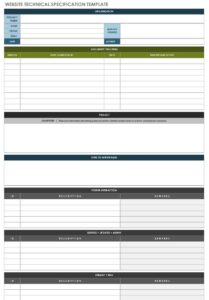Creating an ERP requirements document is a crucial step in selecting and implementing an ERP system that meets your business objectives. This template provides a structured framework to capture your functional, technical, and business requirements in a clear and concise manner.
Before diving into the template, it’s important to engage stakeholders across the organization and conduct thorough research to align the ERP system with your business goals. By actively involving users, managers, and executives in the requirements gathering process, you can ensure that the solution addresses the actual needs of your organization.
Delving into the ERP Requirements Document Template
The ERP requirements document template offers a comprehensive set of sections tailored to capture all aspects of your business needs. It includes sections for:
- Executive Summary: High-level overview of the business problems and objectives that the ERP system aims to address.
- Business Requirements: Detailed description of the current business processes and the desired future state, including functional and operational requirements.
- Functional Requirements: Specific features and functionalities required from the ERP system to support business processes.
- Technical Requirements: Infrastructure, security, and performance requirements for the ERP system.
- Data Requirements: Data sources, data conversion strategies, and data quality expectations.
- Integration Requirements: Interfaces and integrations with other systems, including third-party applications and legacy systems.
- Security Requirements: Access control, data privacy, and disaster recovery measures.
Filling out these sections requires collaboration among various stakeholders. Business users can provide insights into functional requirements, while IT personnel can contribute to technical and integration requirements. The template ensures that all necessary aspects are considered, leading to a well-defined set of ERP requirements.
Importance of a Comprehensive ERP Requirements Document
A comprehensive ERP requirements document template streamlines the requirements gathering process and facilitates clear communication among stakeholders. It provides a solid foundation for evaluating ERP solutions and negotiating with vendors.
By capturing your requirements thoroughly, you can reduce the risk of costly system failures and ensure that the selected ERP system meets the specific needs of your organization. It also serves as a valuable reference point during implementation, training, and ongoing system maintenance.
In conclusion, using an ERP requirements document template is essential for any organization considering an ERP implementation. It helps you define clear requirements, streamline the vendor selection process, and increase the likelihood of a successful ERP project that aligns with your business goals.
Remember, an erp requirements document template is a valuable tool to ensure that your ERP system meets your organization’s unique needs and delivers the desired outcomes.

